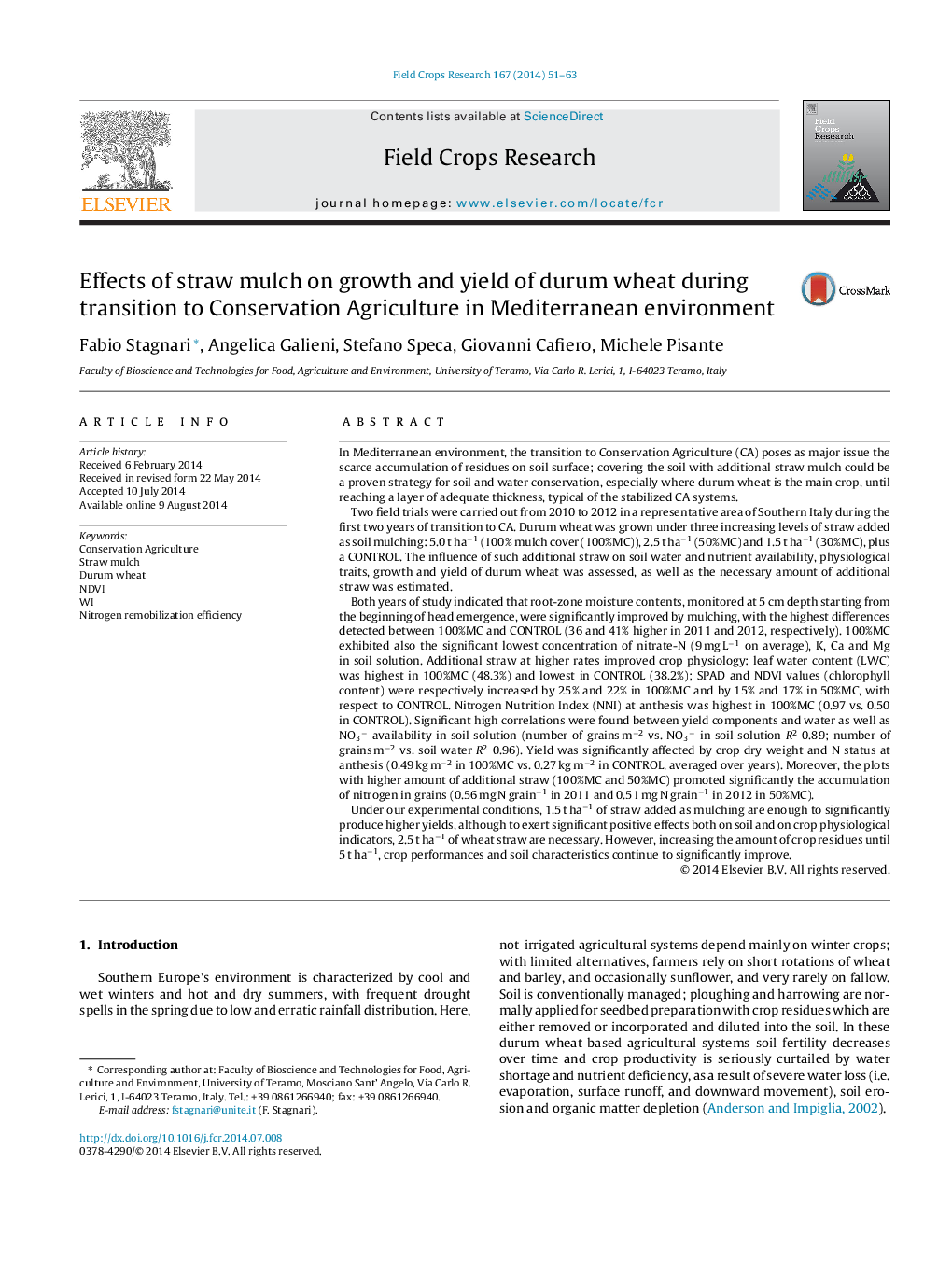| کد مقاله | کد نشریه | سال انتشار | مقاله انگلیسی | نسخه تمام متن |
|---|---|---|---|---|
| 4510064 | 1624696 | 2014 | 13 صفحه PDF | دانلود رایگان |
• Root-zone moisture content (5–15 cm depth) was significantly improved by additional straw mulching.
• The higher the soil mulch level the higher the number of grains per spike and the number of grains per unit ground area.
• Additional straw at higher rates improved crop physiology in terms of leaf water content, SPAD and vegetation indices.
• During the transition phase to Conservation Agriculture, 2.5 t ha−1 of additional straw represent the required amount of residues to exert significant positive effects on both soil and crop status.
In Mediterranean environment, the transition to Conservation Agriculture (CA) poses as major issue the scarce accumulation of residues on soil surface; covering the soil with additional straw mulch could be a proven strategy for soil and water conservation, especially where durum wheat is the main crop, until reaching a layer of adequate thickness, typical of the stabilized CA systems.Two field trials were carried out from 2010 to 2012 in a representative area of Southern Italy during the first two years of transition to CA. Durum wheat was grown under three increasing levels of straw added as soil mulching: 5.0 t ha−1 (100% mulch cover (100%MC)), 2.5 t ha−1 (50%MC) and 1.5 t ha−1 (30%MC), plus a CONTROL. The influence of such additional straw on soil water and nutrient availability, physiological traits, growth and yield of durum wheat was assessed, as well as the necessary amount of additional straw was estimated.Both years of study indicated that root-zone moisture contents, monitored at 5 cm depth starting from the beginning of head emergence, were significantly improved by mulching, with the highest differences detected between 100%MC and CONTROL (36 and 41% higher in 2011 and 2012, respectively). 100%MC exhibited also the significant lowest concentration of nitrate-N (9 mg L−1 on average), K, Ca and Mg in soil solution. Additional straw at higher rates improved crop physiology: leaf water content (LWC) was highest in 100%MC (48.3%) and lowest in CONTROL (38.2%); SPAD and NDVI values (chlorophyll content) were respectively increased by 25% and 22% in 100%MC and by 15% and 17% in 50%MC, with respect to CONTROL. Nitrogen Nutrition Index (NNI) at anthesis was highest in 100%MC (0.97 vs. 0.50 in CONTROL). Significant high correlations were found between yield components and water as well as NO3− availability in soil solution (number of grains m−2 vs. NO3− in soil solution R2 0.89; number of grains m−2 vs. soil water R2 0.96). Yield was significantly affected by crop dry weight and N status at anthesis (0.49 kg m−2 in 100%MC vs. 0.27 kg m−2 in CONTROL, averaged over years). Moreover, the plots with higher amount of additional straw (100%MC and 50%MC) promoted significantly the accumulation of nitrogen in grains (0.56 mg N grain−1 in 2011 and 0.51 mg N grain−1 in 2012 in 50%MC).Under our experimental conditions, 1.5 t ha−1 of straw added as mulching are enough to significantly produce higher yields, although to exert significant positive effects both on soil and on crop physiological indicators, 2.5 t ha−1 of wheat straw are necessary. However, increasing the amount of crop residues until 5 t ha−1, crop performances and soil characteristics continue to significantly improve.
Journal: Field Crops Research - Volume 167, October 2014, Pages 51–63
